The Allure and Importance of Natural Sea Glass
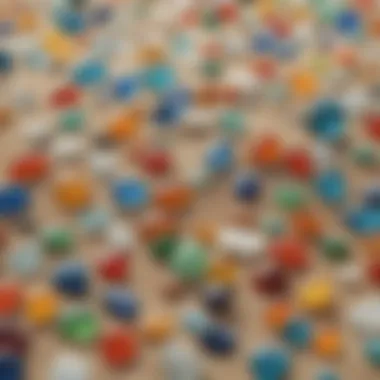
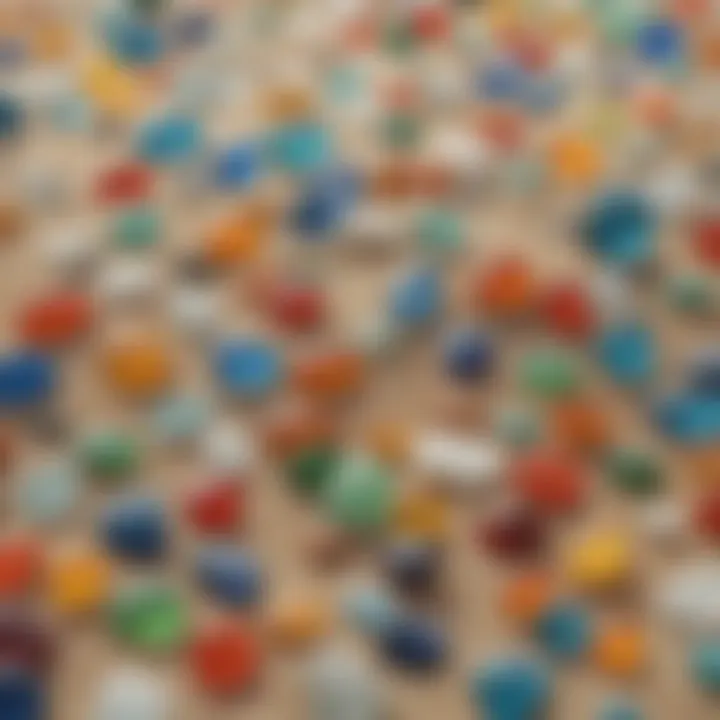
Intro
Natural sea glass holds a certain mystique that captivates collectors and nature lovers alike. Often found strewn along shores, these glass pieces, once discarded, transform from trash to treasure through years of tumbling in the ocean waves. Each shard carries with it a history, a tale of environmental journey, and an allure that has sparked communities and cultures to gather around their beauty.
As we explore the multifaceted world of natural sea glass, we delve into its origins—how it comes into being, its significance within our ecosystems, and the role it plays in art and the creation of jewelry. The charm of sea glass goes beyond its physical appearance; it symbolizes resilience, sustainability, and the intricate relationship between humanity and nature.
Whether you're just dipping your toes into the sea glass hobby or are an experienced collector with an eye for rare finds, there's something here to enrich your understanding and appreciation. Let's journey together through the depths of this oceanic wonder.
Understanding Natural Sea Glass
Natural sea glass is more than just a delightful find on the beach; it's a testimony to the transformative power of nature. Every piece of sea glass has a story, having transitioned from human-made debris to beautiful, smooth gems scattered along coastlines. Understanding sea glass involves recognizing its unique characteristics and the processes that shape it. This knowledge enhances appreciation for its beauty and value, as well as fostering a deeper connection to nature's elements.
Definition and Characteristics
At its core, natural sea glass is simply discarded glass that has been tumbled and smoothed by ocean waters over time. In technical terms, many collectors often emphasize that genuine sea glass possesses certain distinctive features: a frosted appearance that hints at its time spent in the waves, a variety of colors determined by its initial use—everything from cobalt blue bottles to clear glass that perhaps held spirits. It's important to add that these vibrant colors are often hard to come by today, making certain shades rarer and thus more desirable among collectors.
Moreover, the shapes of sea glass vary widely. They can be flat shards, rounded pebbles, or even odd shapes that evoke curiosity. These characteristics not only indicate age but also the history behind each fragment. Over time, a little naivete can lead collectors to mistake artificially manufactured glass for true sea glass, but the texture and edges tell the true tale.
Formation Process
The formation of natural sea glass is a nuanced process undermined by various environmental factors that work in tandem to create each unique piece. Below are three main aspects that contribute to this fascinating transformation.
Weathering and Erosion
Weathering and erosion play pivotal roles in the gradual transition of sharp, discarded glass into soft, charming sea glass. This natural process occurs as the glass is exposed to harsh environmental elements: wind, rain, and, of course, the relentless waves. The edges of the glass become smooth while its surface acquires a frosted texture due to constant friction with sand and rocks. It's the kind of rough-and-tumble experience one might liken to a rite of passage for the glass, a way to rid it of its former identity while gaining a new one.
A key characteristic of this weathering process is time. The longer the glass is submerged and subjected to the whims of mother nature, the smoother and more polished it tends to become. Hence, beachcombers often prize older pieces, which possess a certain patina, adding a touch of nostalgia. Collectors are not just after the aesthetics; they appreciate the history embedded within each piece as well.
Wave Action and Time
The dance between wave action and time is essential in creating the mesmerizing sea glass we admire today. As the waves crash against the shoreline, they continually tumble the glass fragments, subjecting them to a natural polishing process. This action is akin to a persistent partner in a dance, swirling around the glass, guiding its transformation over months, even years.
Wave action introduces another layer of unpredictability. The same piece of glass can be shaped differently depending on the strength and nature of the waves it encounters. For instance, stronger waves might cause more significant abrasion, while calmer waters could lead to slower and gentler smoothing—fascinating how each environment crafts unique outcomes. This interplay of wave action acts as a clarion call for collectors who not only revel in the beauty of pieces but also enjoy the story each individual piece tells.
Types of Glass Materials
Understanding the types of glass materials that become sea glass also enriches the exploration of its value. Glass can originate from various sources, and each type brings its own characteristics. Common sources include bottles, jars, windows, and pottery.
Some glasses are thicker, while others are thinner; each characteristic alters the way these fragments weather in the harsh ocean environment. For example, thicker glass often takes longer to smoothen and may end up with more distinct shapes due to its sturdiness. Conversely, thin glass can break into smaller shards, which may create delicate pieces that sparkle in sunlight.
This diversity adds intrigue when searching for sea glass, as collectors often seek specific types or colors. A well-rounded collection showcases the various forms that glass can take both before and after being shaped by the sea. The difference in characteristics is not only aesthetically pleasing; it also tells an overarching tale of the human impact on nature and what it means in the context of sustainability and environmentalism.
In summary, understanding natural sea glass enriches the collection experience, while shedding light on the environmental processes that shape our world. Recognizing its characteristics—from the story behind the colors to the reasons different types of glass transform uniquely—allows us to appreciate it on multiple levels, anchoring it within a broader understanding of our connection to the natural world.
Historical Context
Understanding the historical context of natural sea glass is essential to appreciate its beauty and cultural significance. Throughout time, sea glass has evolved from discarded materials into treasured artifacts, representing not just environmental stories but also human history. Its journey embodies the intersection of waste and wonder, showcasing how society’s past behaviors have shaped the present. This article acknowledges that recognizing the historical significance provides deeper insight into how both collectors and artisans value sea glass today.
The Origins of Sea Glass
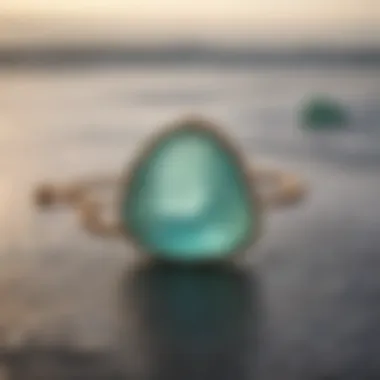
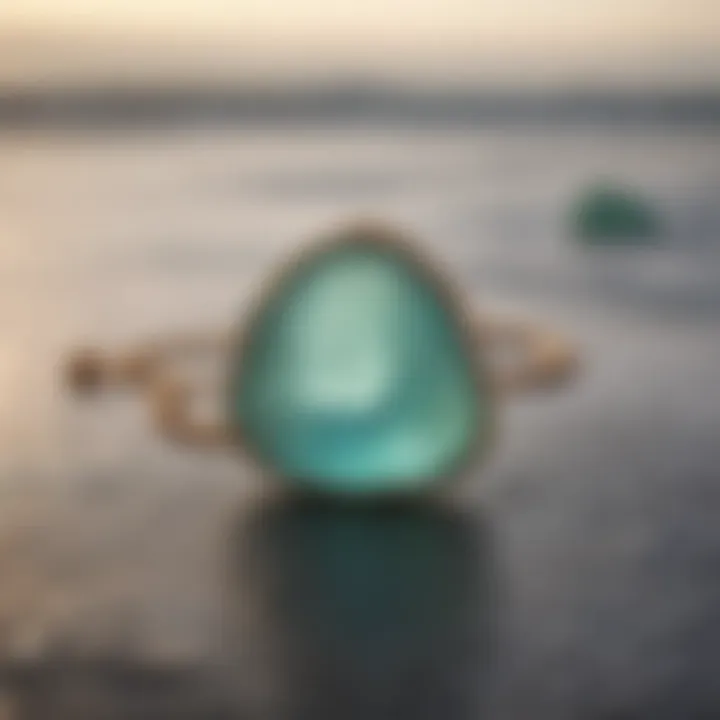
Early Uses and Disposal
One cannot discuss the origins of sea glass without considering how glass artifacts were originally used and discarded. In the 19th and early 20th centuries, glass was a common material for bottles, jars, and vessels. However, once these items were broken or deemed unusable, they often found their way into rivers, oceans, or shorelines rather than proper disposal routes. This careless disposal ultimately led to the long-term transformation of these shards into the polished sea glass we appreciate today.
Key Characteristic: The key aspect of early disposal practices is the sheer volume of waste that was produced, often without thought of the environmental impact. This type of disposal is particularly enlightening, as it emphasizes human behavior that contributed to the beautiful relics we now cherish.
Advantages: Early uses highlighted by environmental ruin led to a unique form of recycling, showing how discarded materials can metamorphose into something aesthetically pleasing over time. The natural weathering process does its part in reshaping these shards, smoothing out sharp edges and creating that eye-catching frosted appearance.
Industrial Influence
The rise of industrialization played a significant role in the production of glass. Factories churned out items en masse, filling shops and homes with a multitude of glass products. This period saw a boom in glass production, providing affordable options for many consumers. However, it also meant that when products were broken or discarded, they contributed massively to oceanic debris.
Key Characteristic: The industrial influence led to a notable increase in glass types, colors, and styles. Each broken bottle or jar carried wit it different nuances, enriching the variety of sea glass collected today.
Advantages: The distinct colors and forms created by industrial glass products mean that today’s sea glass is unique, with variations that tell stories of different eras and origins. This makes it not just a collection of pretty pieces; rather, it stands as a testament to historical production methods and consumption patterns.
Cultural Significance
Symbolism Across Cultures
Sea glass has a rich symbolical layer that varies across different cultures. In many coastal communities, it is seen as a symbol of connectivity—an emblem of nature reclaiming what was once human-made. For some, picking up sea glass on the beach is akin to finding treasure, each piece whispering tales of distant lands and forgotten eras.
Key Characteristic: The way sea glass is perceived culturally showcases a shared appreciation for natural beauty and environmental stewardship, knitting together communities who value this material in various artistic and cultural expressions.
Advantages: This cultural reverence enhances its collecting allure, as each shard represents more than just an object; it signifies resilience and transformation common in various coastal narratives.
Artistic Interpretations
Finally, sea glass has inspired a plethora of artistic interpretations over the years. From jewelry to mosaic art, the versatility of sea glass has attracted artists who seek to incorporate its organic forms into their work. These interpretations often highlight not only aesthetic values but also themes of sustainability and recycling, embedding a deeper meaning into every creation.
Key Characteristic: The ability to turn seemingly useless debris into fine art emphasizes the creativity of humans in repurposing materials.
Advantages: This artistic value connects the past with the present, allowing for continued discussions on environmental ethics, consumer habits, and the artistic resourcefulness of communities embracing sea glass in their creations.
Collection and Community
The world of natural sea glass is not just a solitary endeavor; it thrives on a strong sense of community. The act of collecting sea glass intertwines individuals, forming passionate groups of enthusiasts who share a similar affection for the beauty of objects once discarded. This community offers camaraderie, knowledge exchange, and resources for collectors from all walks of life, making the collection of sea glass not only a rewarding personal activity but also a rich communal experience. As this article unfolds, we will delve into specific aspects that enhance the beauty and value of sea glass through communal involvement and collective joy.
The Thrill of Hunting
Best Locations to Collect
When it comes to gathering natural sea glass, the location is everything. Coastal areas that are less traveled often yield a bounty of treasures, making them appealing to dedicated collectors. Some of the best places to search include remote beaches, abandoned shorelines, and rocky coves where glass has been gradually polished by the relentless ocean waves. For instance, beaches like Glass Beach in Fort Bragg, California, are famous for their colorful glass fragments and serve as a testament to nature's recycling abilities.
The unique characteristic of these locations lies in their history; many were once sites of glass manufacturing or disposal. Over the years, waves and weathering have turned these remnants of human activity into smooth, enchanting pieces of art. However, collectors should exercise caution as some areas may be prone to over-collection, leading to a depletion of resources that may impact the local ecosystem in the long run.
Seasonal Considerations
Another important factor in collecting sea glass is the seasonality of the activity. Spring and summer are generally seen as peak seasons for collecting, with many enthusiasts embarking on their treasure hunts after storms when the ocean’s fury washes ashore new treasures. The changing tides reveal fresh pieces more frequently, adding an element of surprise to each hunt.
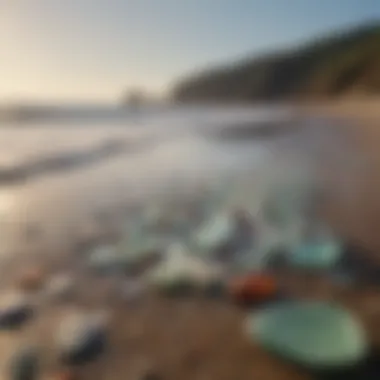
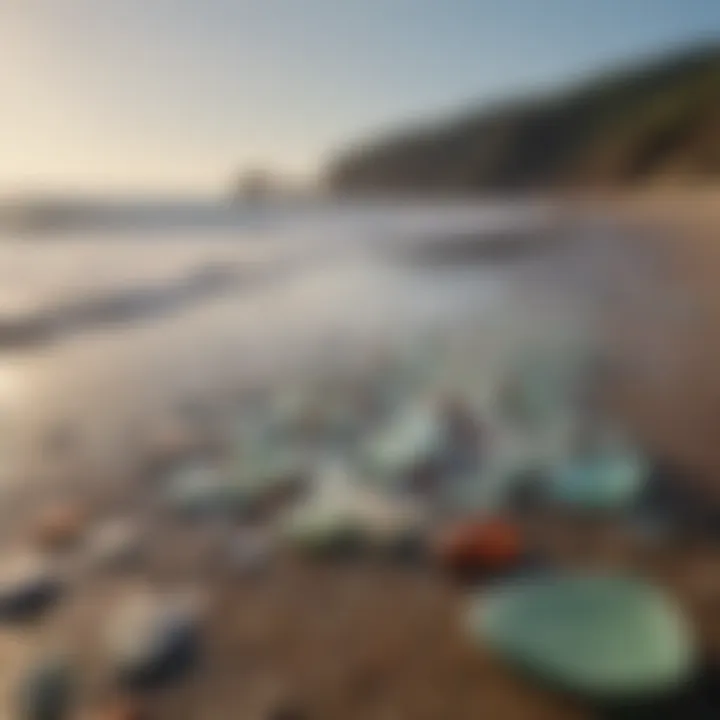
However, different seasons can bring their own unique challenges. Winter storms can mask glass with sand, making it harder to spot, yet they can also uncove hidden gems. Collectors must adapt their techniques based on the season, adding a layer of strategy to the pursuit. Thus, understanding these seasonal dynamics can enhance the thrill of the hunt while inviting a deeper appreciation for the natural rhythms of the ocean.
Building a Community
Social Media and Online Groups
Social media has become a cornerstone for collectors, providing platforms to connect, share, and exchange insights about sea glass. Groups on Facebook and communities on Reddit have sprung up, allowing individuals to share their finds, ask questions, and learn about different crafting techniques. These forums cultivate a wealth of knowledge that enriches the collective understanding of sea glass, making them an invaluable resource.
One fascinating aspect of these online groups is the ability to see diverse collections from around the globe. Whether it's a picture of a lucent green piece from the shores of Cape Cod or an azure fragment found along the coast of Ireland, members can witness the ocean's artistry in action. However, an important consideration is to remain mindful of local regulations about collection to protect the environments we cherish.
Local Gatherings and Events
Local gatherings and events provide an avenue for enthusiasts to connect face-to-face, share stories, and trade pieces. Beach cleanups often serve a dual purpose, where collectors can gather while contributing to environmental well-being. Community events not only bolster the bonds among collectors but also promote awareness about the importance of marine conservation.
These gatherings may feature workshops or exhibitions where local artisans showcase their craft. Participants can learn valuable skills, from sorting through the sea glass to create unique jewelry to employing it in home decor. The sense of connection fostered through these events enriches the experience of collecting. Taking part in such events enhances the feeling of being a part of something bigger; a collective that values the beauty of nature while seeking to preserve it for future generations.
"The joy of collecting sea glass isn't just in the finds, but in the community formed around this shared passion, preserving the beauty of our shores." - A seasoned sea glass collector.
Art and Craftsmanship
Art and craftsmanship hold a significant place in the realm of natural sea glass, transforming mere fragments of glass once discarded into stunning expressions of creativity. The allure of sea glass lies not only in its historical context and ecological significance but also in its capacity to inspire myriad works of art. Crafting with sea glass merges environmental appreciation with artistic ingenuity, highlighting a unique fusion of nature and creativity. Through the varied applications in jewelry making and home decor, artisans elevate these ocean-harvested treasures into meaningful objects, bridging the gap between nature and modern aesthetics.
Jewelry Making
Techniques and Tools
Jewelry making with sea glass requires specific tools and techniques that are often as unique as the glass itself. Various methods, like wire wrapping and beading, enable artisans to shape and showcase the irregular beauty of each piece. Wire wrapping is particularly noteworthy as it allows for the preservation of the glass's natural contours, making it an appealing choice among artisans. Compared to other methods, this technique enhances the raw character of sea glass while offering stability in design.
However, the tools necessary for this craft are equally essential. Tools like pliers, snips, and specialized drill bits for glass all play vital roles. Additionally, the use of specialized adhesives can further enhance designs, allowing creators to incorporate sea glass into various types of jewelry. A disadvantage might be the initial cost of quality tools, but the investment often pays off in the quality of the finished product and the artist's satisfaction.
Showcasing Personal Style
Showcasing personal style through crafted sea glass jewelry is a joyous journey of self-expression. Each piece can reflect individuality, from minimalist designs to extravagant statement pieces. The beauty of working with natural sea glass lies in its inherent imperfection; no two pieces are alike. This uniqueness enables artisans to craft jewelry that feels deeply personal to the wearer while also celebrating the sea's untamed beauty.
A key aspect of showcasing personal style is the ability to incorporate one's own aesthetic preferences into the jewelry. This can include choices of color, shape, and even the combination with other materials like metal or wood. However, it can also pose a challenge: finding the balance between personal taste and market demand can sometimes be tricky, as what resonates with one individual may not appeal to another. Still, the journey of infusing personal style into sea glass jewelry remains rewarding, often enhancing the emotional connection between the creator and the collector.
Home Decor
Design Ideas
When it comes to home decor, natural sea glass offers countless design possibilities that can enrich any space. Simple design ideas can turn ordinary rooms into captivating havens, showcasing the beauty of nature right in one’s home. For instance, filling decorative bowls with colorful sea glass can serve as an elegant centerpiece, bringing a touch of the ocean indoors. Alternatively, crafting picture frames adorned with sea glass can add a coastal charm that’s hard to replicate using traditional materials.
A unique feature of design ideas incorporating sea glass is their versatility; they can fit various aesthetics, from beachy to contemporary, effortlessly. However, the primary challenge often lies in the balance between creating cohesive designs while allowing the natural beauty of the glass to shine through. Careful consideration of the surrounding decor is necessary to ensure harmony rather than chaos.
Enhancing Aesthetic Spaces
The process of enhancing aesthetic spaces involves thoughtfully integrating sea glass into different environments. The ethereal qualities of sea glass evoke a calm, serene atmosphere that many seek in their homes. Using sea glass in lighting fixtures, for instance, can diffuse light beautifully, creating stunning visual effects that enchant visitors.
Moreover, utilizing sea glass doesn't has to be confined to decorative items; it can be part of larger installations or artistic expressions. The key lies in how it connects with the overall design scheme. One advantage is its ability to blend seamlessly with natural materials like wood or stone, adding a layer of depth and texture to any design.
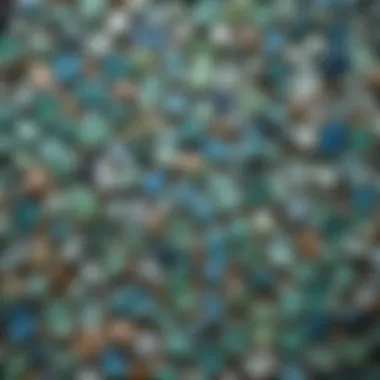
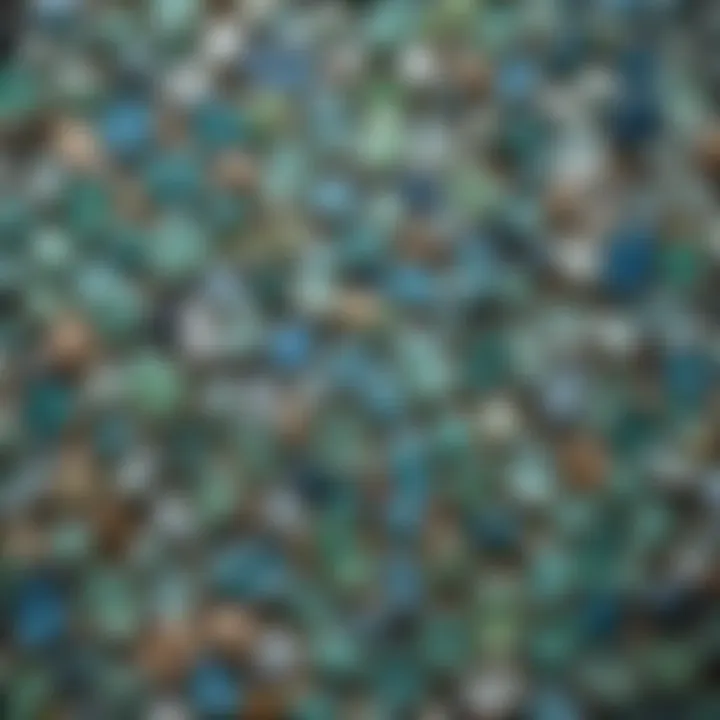
While incorporating sea glass into decor, remember that less can often be more. Too much can overwhelm, while a thoughtful selection can create focal points that draw the eye without feeling cluttered.
With its environmental roots and artistic possibilities, natural sea glass not only adorns spaces but also tells a story – one of the ocean's past and the artistic visions of today.
Environmental Impact
The exploration of natural sea glass brings with it an important conversation about the environment. Sea glass isn’t just a beautiful artifact; it plays a role in ecosystems, acts as a reflection of human impact on nature, and necessitates sustainable practices. Understanding these factors enriches our appreciation of sea glass and highlights its significance beyond aesthetics.
Role of Sea Glass in Ecosystems
Habitat Creation
Natural sea glass contributes significantly to habitat creation along shorelines. Over time, the smooth pieces of glass can intermingle with sand and rocks, providing diverse substrates for various marine organisms. This is critical because the textured surface of sea glass can offer attachment points for algae and small invertebrates, fostering a mini-ecosystem in coastal regions.
What makes habitat creation by sea glass particularly fascinating is its natural incorporation into the environment through weathering processes. As glass wears down and rounds off under relentless wave action, it becomes part of the coastal fabric rather than a simple byproduct of human consumption. This natural integration is a beneficial characteristic that encourages biodiversity by providing shelter and sustenance. However, the sheer abundance of human-made materials in coastal regions also raises concerns about the ecological balance. Too much glass and other debris can disrupt local habitats and create competitive environments that favor invasive species, which poses a disadvantage to native marine life.
Interaction with Marine Life
The interaction of marine life with sea glass presents a captivating aspect that underscores its value. Fish, crustaceans, and even sea turtles can utilize these glass treasures for various reasons, from nesting opportunities to camouflage against predators. Many species have adapted to using the environment around them creatively, and natural sea glass has become part of that dynamic.
The vivid colors of sea glass can also entice small fish, which may hide in crevices formed by glass structures. Such interactions not only enhance marine biodiversity but also draw attention to the delicate connections within aquatic ecosystems. Yet, it is important to note that contaminants on certain glass pieces may pose risks and health challenges to marine organisms, highlighting the need for responsible collection and disposal practices.
Sustainability Considerations
Impact of Human Activity
The human footprint on coastal ecosystems cannot be overstated. The production, disposal, and accumulation of glass has led to significant changes in how sea glass is perceived and its role within the environment. While sea glass can serve as a positive example of recycling, the overall impact of human activities often presents a mixed bag.
Glass that enters the marine environment through waste can introduce toxins affecting both wildlife and people, showcasing that whilst sea glass can be seen as a treasure, its origins are often anything but pure. Reducing litter and prioritizing proper waste management are essential steps to ensure that the existence of sea glass remains a positive environmental story, not merely a consequence of human negligence.
Conservation Efforts
Conservation efforts aimed at protecting marine environments are integral in balancing the environmental narrative surrounding sea glass. These initiatives can range from beach clean-ups to legislative changes that promote sustainable practices in coastal management. Many organizations have sprung up, advocating for stronger protections and clean-up operations, inadvertently increasing awareness about the beauty and value of sea glass.
The key characteristic of these efforts is community involvement. Grassroots movements have mobilized people who cherish natural sea glass to participate actively in environmental stewardship. The unique feature of conservation efforts is that they not only work to clean up marine debris but also promote the understanding that beauty like sea glass can emerge from waste. This dual focus empowers individuals to become part of a larger movement, fostering a culture of respect and sustainability.
"True beauty in nature often arises from the most unexpected sources."
Epilogue
Natural sea glass carries with it a myriad of layers, both literally and figuratively. In concluding this exploration, it’s critical to chart not only the aesthetic appeal of these colorful treasures but also their deeper significance within various contexts. The journey of sea glass, from discarded remnants to cherished collectibles, embodies a narrative of resilience and transformation. This alone underscores the importance of recognizing and appreciating this unique material within our lives and communities.
Reflections on Natural Sea Glass
Value Beyond Aesthetics
The value of natural sea glass extends far beyond its visual charm. While its unique colors and smooth textures attract collectors and artists alike, the underlying stories that each piece tells hold just as much importance. Each shard found along the shore mirrors a tale of human influence, environmental perseverance, and natural artistry. This aspect makes sea glass not only a decorative item but also a conversation starter, encouraging discussions about sustainability, history, and the delicate balance between mankind and nature.
Moreover, the community surrounding sea glass tends to be passionate and knowledgeable, making it possible for newcomers to tap into this wealth of information. As people share their experiences, they contribute to an ongoing dialogue about respecting the environment while enjoying its bounty. This aspect highlights how sea glass serves as a reminder of responsible stewardship, reiterating that it’s a beneficial choice for enthusiasts who appreciate not just beauty, but also the stories behind each piece.
Future of Sea Glass Collections
Looking toward the future, the landscape of sea glass collections appears promising yet changeable. Many collectors are increasingly prioritizing sustainability, prompting a shift in how these collections are curated. There's a movement towards ethical gathering practices that ensure oceanic environments remain unspoiled while still satisfying the thrill of the hunt.
Furthermore, technology plays a pivotal role in this evolution. With the rise of social media platforms like Instagram and online forums on Reddit, enthusiasts can share their finds and connect with others globally, fostering a sense of community. Such technology not only elevates visibility for sea glass artistry but also has sparked interest in workshops and events, allowing individuals to learn more about the craft of working with these materials.
While the future of sea glass collections contains its fair share of advantages, challenges also loom. Environmental changes and pollution threaten the supply of high-quality finds, thus raising questions about the longevity and sustainability of this pursuit. However, with a growing commitment to conservation and environmentally friendly practices, there remains hope that both future collectors and lovers of natural sea glass can continue to enjoy this beautiful aspect of our natural world.







